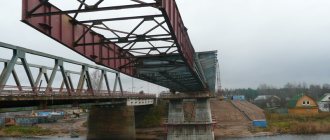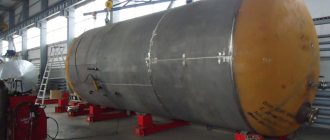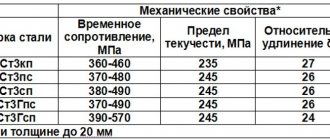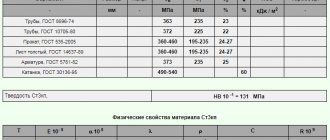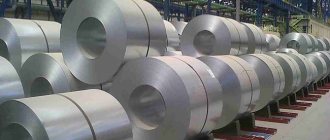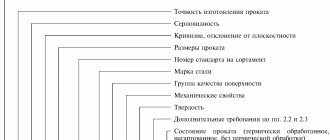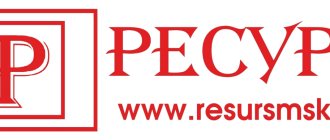- Types and characteristics of deoxidizers
- Mild steel grades
- Advantages of quiet alloys
- Application areas of mild steel
- Differences between calm and semi-quiet steels
Calm steel contains a minimal amount of oxygen. In the classification according to the degree of deoxidation, it ranks first after boiling and semi-calm steels. Mild steel is obtained by enriching the original alloy with deoxidizing agents. They remove oxygen from the molten alloy, thereby improving its mechanical properties. The metal becomes denser, more resistant to heat and corrosion.
Types and characteristics of deoxidizers
When deoxidizing agents are introduced into the liquid metal, they combine with oxygen and are removed before the ingot solidifies. The process produces liquid, solid and gaseous deoxidation products, the quantity of which determines the quality of steel.
The alloy is deoxidized by introducing additives in strictly prescribed quantities. These include:
- ferrosiscilium - add 0.12-0.3% of the total mass;
- aluminum - up to 0.1%;
- ferromanganese - up to 0.1%;
- silicon - up to 0.05%;
- titanium.
Aluminum, silicon, manganese and complex deoxidizers are most often used in the precipitation deoxidation method. Less commonly, oxygen is removed from steel by diffusion, vacuum or electroslag deoxidation. After processing, a large shrinkage cavity is formed, which causes the price of smooth steel to increase. The shrinkage hole, as a defect in the casting of the alloy, cannot be used, so it is cut off from the main part. On average, a cast ingot loses up to 16% of the mass of the workpiece.
Boiling steel
Boiling steel is characterized by: - a high degree of gas evolution during the solidification of steel in the mold; — a noticeable difference in the chemical composition across the cross section of the ingot and between the upper and lower parts of the ingot (see figure).
This leads to the formation of relatively pure iron in the outer shell of the ingot and the inner core of the ingot with a high concentration of alloying and impurity elements, especially carbon, nitrogen, sulfur and phosphorus, which have a low melting point. The cleaner outer part of the ingot is used during rolling. Boiling steel ingots are well suited for the production of many products such as plates, sheets, wire, pipes, as well as long products with requirements for surface cleanliness and toughness properties.
The technology for producing boiling steels is limited by the maximum content of carbon and manganese. This steel does not contain any noticeable amounts of strong deoxidizing agents such as aluminum, silicon or titanium. Boiling steel is cheaper than calm and semi-calm steel, since only a small amount of deoxidizer is used for it, and the upper part of the ingot is not scrapped.
Mild steel grades
If you want to know which ordinary quality steel is considered mild steel, read the markings. For mild steel, grades are designated by conventional numbers depending on the chemical composition. The designation includes letters and numbers. For example, the St1sp brand means:
- structural carbon steel of ordinary quality - St;
- conditional brand number - 1;
- degree of deoxidation - SP (calm).
Requirements for metal quality are set out in GOST 380-2005.
Semi-quiet steel
In semi-quiet steel, the release of gases during its deoxidation is not completely suppressed, since the steel is only partially deoxidized. In English it is called semikilled
steel
. The degree of gas evolution in these steels is greater than in calm steels, but less than in boiling steels. Before the release of gases begins, a crust of considerable thickness forms in the ingot. A properly “semi-deoxidized” steel ingot does not have a shrinkage cavity, but there are bubbles widely dispersed throughout the thickness in the central zone of the upper part of the ingot. These bubbles, however, are sealed when the ingot is rolled. Semi-quiet steels typically have a carbon content of 0.15 to 0.30%. They are widely used in the production of long products, strips and pipes.
The main differences between semi-quiet steels are: 1) different degrees of heterogeneity of the chemical composition - average between the degrees of calm and boiling steels; 2) less segregation of chemical elements than in plain steel; 3) a pronounced tendency for positive chemical segregation in the center of the upper part of the ingot (figure).
Advantages of quiet alloys
The metal is characterized by:
- homogeneous structure;
- low fragility;
- weldability;
- resistance to dynamic loads;
- lower content of impurities compared to steels that can boil.
The disadvantage of quiet alloys is their high price, justified by the addition of deoxidizing agents and the removal of the shrinkage cavity.
Thanks to its acquired qualities, mild steel is classified as a structural carbon alloy used in critical areas.
Steel grades - table with markings and interpretation
Any specialist who deals with metal is familiar with the concept of “steel grade”. Deciphering the markings of steel alloys makes it possible to get an idea of their chemical composition and physical characteristics. Understanding this marking, despite its apparent complexity, is quite simple - it is only important to know on what principle it is compiled.
Rarely does production operate without steel, so understanding its grades is extremely important
The alloy is designated by letters and numbers, which can be used to accurately determine which chemical elements it contains and in what quantity. Knowing this, as well as how each of these elements can affect the finished alloy, it is possible to determine with a high degree of probability exactly what technical characteristics are characteristic of a particular grade of steel.
Types of steels and features of their markings
Steel is an alloy of iron and carbon, the content of which is no more than 2.14%. Carbon gives the alloy hardness, but if it is in excess, the metal becomes too brittle.
One of the most important parameters by which steels are divided into different classes is the chemical composition. Among the steels according to this criterion, alloyed and carbon steels are distinguished, the latter are divided into low-carbon (carbon up to 0.25%), medium-carbon (0.25–0.6%) and high-carbon (they contain more than 0.6% carbon).
By including alloying elements in the steel, it can be given the required characteristics.
It is in this way that, by combining the type and quantitative content of additives, grades with improved mechanical properties, corrosion resistance, magnetic and electrical characteristics are obtained.
Of course, it is possible to improve the characteristics of steels using heat treatment, but alloying additives make it possible to do this more efficiently.
Based on the quantitative composition of alloying elements, low-, medium- and high-alloy alloys are distinguished. In the first alloying elements there is no more than 2.5%, in medium alloyed elements - 2.5–10%, in highly alloyed ones - more than 10%.
Steels are classified according to their purpose. Thus, there are instrumental and structural types, grades distinguished by special physical properties.
Tool types are used for the production of stamping, measuring, and cutting tools, structural ones - for the production of products used in construction and mechanical engineering.
Alloys with special physical properties (also called precision) are used to make products that must have special characteristics (magnetic, strength, etc.).
Classification of steels by purpose
Steels are also contrasted with each other based on their special chemical properties. Alloys of this group include stainless, scale-resistant, heat-resistant, etc. Typically, stainless steels can be corrosion-resistant and stainless steel for food - these are different categories.
In addition to useful elements, steel also contains harmful impurities, the main ones of which are sulfur and phosphorus. It also contains gases in an unbound state (oxygen and nitrogen), which negatively affects its characteristics.
If we consider the main harmful impurities, phosphorus increases the brittleness of the alloy, which is especially pronounced at low temperatures (the so-called cold brittleness), and sulfur causes cracks in metal heated to high temperatures (red brittleness).
Phosphorus, among other things, significantly reduces the ductility of heated metal.
Based on the quantitative content of these two elements, steels are divided into ordinary quality (no more than 0.06–0.07% sulfur and phosphorus), high-quality (up to 0.035%), high-quality (up to 0.025%) and especially high-quality (sulfur - up to 0.015%, phosphorus - up to 0.02%).
The marking of steels also indicates to what extent oxygen has been removed from their composition. According to the level of deoxidation, steels are divided into:
- calm type, designated by the letter combination “SP”;
- semi-calm - “PS”;
- boiling - “KP”.
What does the steel marking mean?
It has become quite easy to decipher the brand; you just need to have certain information. Structural steels of ordinary quality and not containing alloying elements are marked with the letter combination “St”.
By the number following the letters in the name of the brand, you can determine how much carbon is in such an alloy (calculated in tenths of a percent). The numbers may be followed by the letters “KP”: from them it becomes clear that this alloy has not completely gone through the deoxidation process in the furnace, and accordingly, it belongs to the boiling category.
If the brand name does not contain such letters, then the steel corresponds to the calm category.
Chemical composition of carbon structural steels of ordinary quality
Structural unalloyed steel, which belongs to the quality category, has two numbers in its designation; they are used to determine the average carbon content in it (calculated in hundredths of a percent).
Before we begin to consider the grades of those steels that include alloying additives, you should understand how these additives are designated. Marking of alloy steels may include the following letter designations:
List of alloying additives used
Designation of steels with alloying elements
As mentioned above, the classification of steels with alloying elements includes several categories. The marking of alloy steels is compiled according to certain rules, knowledge of which allows one to quite simply determine the category of a particular alloy and the main area of its application.
In the initial part of the names of such brands there are numbers (two or one) indicating the carbon content. Two numbers indicate its average content in the alloy in hundredths of a percent, and one – in tenths. There are also steels that do not have numbers at the beginning of the brand name.
This means that the carbon content in these alloys is within 1%.
Example of alloy steel marking
The letters that can be seen behind the first digits of the brand name indicate what the alloy is made of.
The letters that give information about a particular element in its composition may or may not be followed by numbers.
If there is a number, then it determines (in whole percentages) the average content of the element indicated by the letter in the alloy, and if there is no number, it means that this element is contained in the range from 1 to 1.5%.
At the end of the marking of certain types of steel there may be the letter “A”. This suggests that this is high quality steel. These grades may include carbon steels and alloys with alloying additives in their composition. According to the classification, this category of steels includes those in which sulfur and phosphorus amount to no more than 0.03%.
Examples of marking steels of various types
Determining the grade of steel and assigning an alloy to a certain type is a task that should not cause any problems for a specialist. You don’t always have a table at hand that gives a breakdown of brand names, but the examples given below will help you figure it out.
elements in common steel grades (click to enlarge)
Structural steels that do not contain alloying elements are designated by the letter combination “St”. The numbers following are the carbon content, calculated in hundredths of a percent. Low-alloy structural steels are marked somewhat differently.
For example, 09G2S steel contains 0.09% carbon, and alloying additives (manganese, silicon, etc.) are contained within 2.5%. 10KhSND and 15KhSND, which are very similar in their markings, differ in different amounts of carbon, and the share of each alloying element in them is no more than 1%.
That is why there are no numbers after the letters indicating each alloying element in such an alloy.
20Х, 30Х, 40Х, etc. – this is how structural alloy steels are marked; the predominant alloying element in them is chromium.
The number at the beginning of such a mark is the carbon content in the alloy in question, calculated in hundredths of a percent.
The letter designation of each alloying element can be followed by a number, which is used to determine its quantitative content in the alloy. If it is not there, then the specified element in the steel contains no more than 1.5%.
You can consider an example of the designation of chromium-silicon-manganese steel 30KhGSA. According to the labeling, it consists of carbon (0.3%), manganese, silicon, and chromium. It contains 0.8–1.1% of each of these elements.
How to decipher steel markings?
To make deciphering the designations of different types of steels easy, you should know well what they are. Certain categories of steel have special markings. They are usually designated by certain letters, which allows you to immediately understand both the purpose of the metal in question and its approximate composition. Let's look at some of these brands and understand their designation.
Properties and purpose of structural alloy steels
Structural steels specially intended for the manufacture of bearings can be recognized by the letter “Ш”; this letter is placed at the very beginning of their marking.
After it in the brand name there is a letter designation of the corresponding alloying additives, as well as numbers by which the quantitative content of these additives is determined.
Thus, steel grades ShKh4 and ShKh15, in addition to iron and carbon, contain chromium in amounts of 0.4 and 1.5%, respectively.
The letter “K”, which appears after the first digits in the brand name, indicating the quantitative carbon content, denotes structural non-alloy steels used for the production of vessels and steam boilers operating under high pressure (20K, 22K, etc.).
High-quality alloy steels, which have improved casting properties, can be recognized by the letter “L” at the very end of the marking (35ХМЛ, 40ХЛ, etc.).
Deciphering the grades of construction steel can cause some difficulty if you do not know the specifics of the markings. Alloys of this category are designated by the letter “C”, which is placed at the very beginning. The numbers following it indicate the minimum yield strength. These brands also use additional letter designations:
- letter T – heat-strengthened rolled products;
- letter K – steel, characterized by increased corrosion resistance;
- letter D is an alloy characterized by a high copper content (S345T, S390K, etc.).
Unalloyed steels belonging to the tool category are designated by the letter “U”; it is affixed at the beginning of their marking. The number following this letter expresses the quantitative carbon content in the alloy in question.
Steels of this category can be high-quality and high-quality (they can be identified by the letter “A”, it is placed at the end of the brand name).
Their marking may contain the letter “G”, which means a high content of manganese (U7, U8, U8A, U8GA, etc.).
Tool steels containing alloying elements in their composition are marked similarly to alloyed structural steels (KhVG, 9KhVG, etc.).
Composition of alloy tool steels (%)
The marking of those steels that are included in the high-speed cutting category begins with the letter “P”, followed by numbers indicating the quantitative content of tungsten. Otherwise, brands of such alloys are named according to the standard principle: letters denoting the element, and, accordingly, numbers reflecting its quantitative content.
The designation of such steels does not indicate chromium, since its standard content in them is about 4%, as well as carbon, the amount of which is proportional to the vanadium content.
If the amount of vanadium exceeds 2.5%, then its letter designation and quantitative content are affixed at the very end of the marking (З9, Р18, Р6М5Ф3, etc.).
The influence of some additives on the properties of steel
Unalloyed steels belonging to the electrical category are marked in a special way (they are also often called pure technical iron). The low electrical resistance of such metals is ensured due to the fact that their composition is characterized by a minimum carbon content - less than 0.04%. There are no letters in the designation of grades of such steels, only numbers: 10880, 20880, etc.
The first digit indicates the classification by type of processing: hot-rolled or forged - 1, calibrated - 2. The second digit is associated with the category of the aging coefficient: 0 - non-standardized, 1 - standardized. The third digit indicates the group to which this steel belongs according to the standardized characteristic taken as the main one.
The value of the standardized characteristic itself is determined from the fourth and fifth digits.
The principles by which the designation of steel alloys is carried out were developed back in the Soviet period, but to this day they are successfully used not only in Russia, but also in the CIS countries. Having information about a particular grade of steel, you can not only determine its chemical composition, but also effectively select metals with the required characteristics.
Understanding this issue is important both for specialists who develop and design various metal structures, and for those who often work with various steels and manufacture parts from them for various purposes.
Why choose D2
When choosing steel for knives, there are more than 15 brands of different chemical composition and properties, we are guided primarily by physical and chemical indicators, on which the basic properties of the blade depend. These can be throwing knives, then ductility is important for them so that they can withstand dynamic blows and bend, but in this case the blade will not be enough to refresh the carcass without several adjustments. But blades that hold an edge for a long time are not intended for throwing, opening bottles or driving nails.
The second selection criterion is mass production and the final cost of the product. For example, household knives should be corrosion-resistant, hold an edge, but not necessarily for a long time, but most importantly, be inexpensive. Therefore, it is expensive to use very expensive steel for the production of household products, even if you try to reduce the cost through mass production.
Corrosion resistance is the third factor, apparently not the most important one when it comes to the ability to hold an edge. It is grade D2 steel that pushes this condition into the background, since it can corrode when exposed to water for a long time, even if not actively.
D2 steel is optimal both in terms of physical and chemical properties and cost. When stored correctly (constant contact with water or any contact with acids is avoided), the knives will last a very long time. And their cost is in the range of 15-35 USD. e.
Rate this article:
Rating: 5/5 — 2 votes
Thermo-mechanical treatment
Steel D2 is classified as cutting steel. Such grades are subjected to hardening to impart maximum strength (57 Rockwell units in the annealed state, after quenching and tempering 61 units). The bulk of the steel undergoing hardening is heated in an oxidizing atmosphere, but for knives, an unusual technology is used due to the difference in thickness between the edge and the main thickness of the knife. That is, it is important to ensure uniform heating and obtain a uniform structure throughout the entire body of the blade: both in the edge and in the butt. At the same time, avoid warping of the metal.
Heating for hardening in an oxidizing atmosphere leads to partial decarburization of the upper layers, which are removed by final processing. But knife blanks are hardened to exact dimensions, since after heat treatment the steel becomes very strong and therefore the final mechanical processing that is applied to it is grinding and sharpening the cutter.
Heating is carried out in salt baths at a temperature of 850-630 ºC. To heat the entire thickness of the workpiece, a few seconds or minutes are sufficient, after which the metal is cooled in air. In order for the matrix to heat up in a matter of seconds and turn into an austenitic state, the steel is alloyed with molybdenum and vanadium, which not only increase the wear resistance of the knife, but also increase the hardenability.
Advantages and disadvantages
Knife made of D2 steel.
The advantages include:
- ability to hold an edge for a long time;
- hardness;
- resistance to aggressive environments;
- ability to withstand strong blows.
The products hold their edge for a long time even with active use. Steel is resistant to environmental influences and does not deform; it can withstand even high temperatures. The high carbon content makes the cut aggressive. Hardness contributes to good wear resistance, which allows the blade to be used for working with a wide variety of materials, including high-strength materials.
Flaws:
- susceptibility to corrosion;
- difficulty of sharpening.
The alloy does not contain enough chromium to be stainless. Therefore, stains may appear on the surface of the metal, especially after contact with a humid or acidic environment. Products made of this steel should be wiped after contact with water or other liquids or covered with a special anti-corrosion material.
The metal itself is difficult to polish, so the surface of the products always looks matte. During the sharpening process, you should remember the choice of angle: the sharpening tool must be set at 25-35°, otherwise the hard steel will crumble.
This variety has more advantages than disadvantages; reviews are mostly positive.
Comparative characteristics of steel D2 and Kh12MF
The analogue in the Russian Federation is steel X12MF.
D2 steel contains carbon. Vanadium is used as alloying elements, which reduces the fragility of the blade, molybdenum improves the hardenability of the material to the full depth. Chromium protects steel from corrosion, but its level is not sufficient to classify the steel as stainless. Also, having melted, it is alloyed with silicon and manganese, the first element strengthens the steel grains, the second increases its hardness.
- Carbon – 1.4-1.6%.
- M-0.9-11%
- Mo- 0.8-1.2%
- Cr-11%.
The steel has a very aggressive and long lasting cut. Easy to sharpen and straighten. It is advisable to use ceramic abrasives for sharpening; diamonds form a too rough cutting edge. Or use diamond abrasives for initial roughening, and then move on to ceramics.
The steel resists corrosion quite well, but it cannot be classified as stainless steel because it lacks chromium. The knives will require simple care; wash and wipe after use. Pitting corrosion can be easily removed with a regular eraser.
The optimal heat treatment mode is 58-60 units. According to Rockwell, with such hardness the blade has balanced characteristics. The sharpness of the cutting edge is well maintained and at the same time the edge is not prone to chipping under strong lateral or impact loads. In the case of heat treatment at a hardness of 60-62 units. according to Rockwell, wear resistance increases noticeably, but at the same time the knife becomes brittle. For example, if you hit a bone with a knife while cutting up a carcass, you can get chips.
The advantages of knives from D2 include:
- Long time of maintaining the sharpness of the cutting edge;
- Good corrosion resistance;
- It has sufficient mechanical strength to withstand chopping blows without damage;
- As a rule, knives made of this steel have an acceptable cost.
The disadvantages include;
- In conditions of prolonged exposure to a humid environment, it is prone to the formation of corrosion spots;
Analogues of the alloy and its application
The D2 steel grade was developed in the 60s of the last century in the United States and was originally used for industrial needs. The alloy was used to make high-speed metal cutters that could operate at high temperatures. Today this brand is popular all over the world and has many analogues:
- Х155CrMo12 – in Germany;
- SLD - Japan;
- 1.2379 – in the European Union;
- SKD-11 - Sweden.
In Russia, a substitute for D2 steel is the X12MF grade, the composition of which is regulated by GOST 5950. Its range is represented by:
- various types of rental;
- calibrated rod and silver;
- strip and forged blanks.
Tool steel D2, like its analogues, has found wide application:
- in the engineering industry;
- production of metalworking tools;
- razor blades.
It is especially in demand as a material for the manufacture of elite knives, which is due to its ability to maintain a good sharpening for a long time. Normally it should be enough to cut up a large carcass. A wide range of knives are made from the alloy:
- universal folding ones, including gift options;
- neck hunting knives designed for skinning prey;
- tourist, having a wide range of applications;
- cutting, for cutting large carcasses.
Technical features of D2 steel
The D2 grade is an American marking that is also used here, indicating precise use. The existing Russian analogue is X12MF steel. Both in chemical composition and mechanical properties, these brands are similar. There is only a difference in the range of components used. But more properties depend on thermal processing.
This brand has become very famous in its country; many companies use it for their products: cutting tools for equipment, knives. It is in demand thanks to:
- low cost;
- good machinability;
- sharpening resistance;
- high cutting characteristics;
- corrosion resistance;
- homogeneity of the structure after hardening.
History of the appearance of the alloy
Steel grade D2 plate 250x80x4 mm. The alloy was developed in America in the 60s. for industrial purposes (production of knives and cutting tools). Nowadays such steel is produced not only in the USA. Alloys similar in composition to D2 have been developed in Japan, Germany and Sweden. The only difference is the amount of carbon.
The alloy has the following designations:
- X155CrMo12 – produced in Germany;
- 1.2379 – this is how D2 is marked according to the European steel designation system;
- SLD – alloy in Japan;
- SKD-11 – D2 marking in Sweden.
In Russia there is also an analogue - X12MF.
The alloy is actively used in the metalworking industry, automotive industry, and in the production of razor blades. In addition, it is used to create edged weapon blades.

